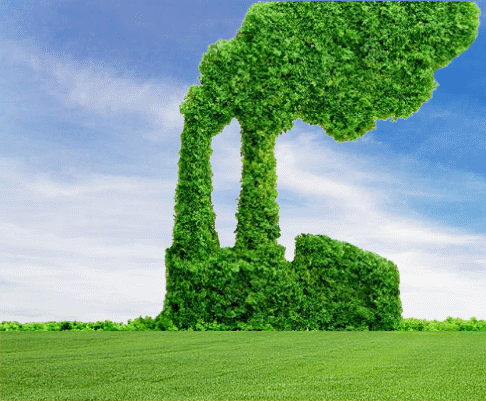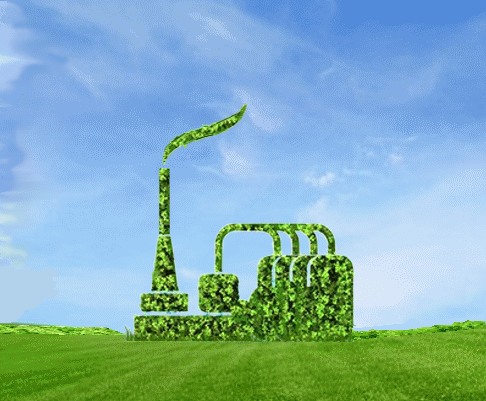

Index Home Desert-Electricity World Deserts Electric Network Types of Produktion Comparison Water Network Hydrogen New Industry Green Cities Energy Transition Imprint
New circular industry
Green industry
In a green industry, products are produced using emission-free energy. But that's not all! A truly green industry is also a circular industry. In a circular industry, all the products that are created are used again and again. They are dismantled, physically or chemically broken down and the raw materials they contain are returned to the production cycle. All products are characterized by the longest possible lifespan and can be repaired again and again for a very long time or the raw materials can be reused.



The biggest problem with our current economic system is waste. Even when we produce, we create waste, residues, poisons and much more, which we simply release into the air from chimneys, lead through pipes into rivers or dispose of with trucks on landfills. But it's not just a problem because waste itself is a problem, but because it shows that we simply consume. We use up important resources and then just throw them away. But the earth doesn't work that way and not only does the earth not work that way, but the entire universe doesn't work that way. Nothing is thrown away in the universe.
But why do we do it then? We build or brew something together and cannot or do not want to reconstruct it afterwards. Because it's simply not intended. It is not part of the sales strategy. For example, it would be far too expensive to build something so that it can easily be taken apart again. It would be too expensive to recover resources through chemical means. In short, of course, it is cheaper to throw away resources and create new products with new raw materials.
It's not about creating products at all! It's about creating something that generates high profits as quickly as possible. So if we were to create real products that could then be dismantled and the raw materials reintegrated into the production cycle, the products would be so expensive that you couldn't keep buying a new product or the profits wouldn't be that great.
It would not be possible to finance generous interest or returns from this, and there would be no possibility of obtaining more money with loaned money without having to do any work for it. But that's what this type of business is all about. Since money increases exponentially through interest and returns and more and more interest and returns must be generated, increasing exponentially, the economy must also grow exponentially.
This results in constantly growing, senseless mass production, in which the products have to become ever cheaper. The production processes, the energy used, the materials, the workforce and of course the disposal routes for waste must become increasingly cheaper. Entire states are constantly becoming more and more indebted because taxes no longer reflect reality. Galloping inflation is once again affecting highly developed industrialized countries. The surface of the earth is overheated by this activity and we are endangering our survival.
And yet all of this is not enough, because it is almost impossible to maintain an exponential growth of capital with interest and/or returns. It is practically impossible to create a green industry under these conditions. Only investments are made that increase production in the short term, reduce costs and increase profits exponentially. It is also very significant that the respective citizens of a country can no longer survive sensibly without this exponential economic growth, which is heating up our earth and endangering our survival. Particularly worrying: There are disputes over territories and thus renewed war situations. The poor countries of the world are the losers of this activity; they have to flee their war-torn and/or impoverished countries and find accommodation in richer countries as unloved immigrants.
An investment in research: Not only creating things and materials but also dismantling them and using them again and again is only possible if we change the interest and return options in this sector and, above all, the laws for the creation and distribution of products adapt the existing reality.
- A zero emissions law must be above all else! Anyone who creates and sells something is fully responsible and liable for it, including for its reverse development. Disposing of it into nature is then no longer possible.
- New raw materials must be so expensive that it is only worthwhile to create new products with recycled raw materials. This turns reverse engineering research into an investment that is worthwhile.
- Production itself may only make a profit if it corresponds to the principles of reason. Returns and interest are only available for investments that meet the high goals of a sensible industry.
- Individual freedom of entrepreneurship must be limited to protect the earth, the plants, animals and people who live on it. The prevailing procedure at the moment corresponds to the facts of intentionally negligent bodily harm.
- The legislation needs to be fundamentally revised. The state, together with scientists, must be able to decide what and how to do anything.
If we use interest and returns for control, we will manage to create a truly green and therefore sensible circular industry.
An example: Anyone who invests in the development of the international energy and water network receives a lot of interest and/or returns; the state decides with the help of artificial intelligence how high the rates will be. Overhangs are made available to the state, which in turn allows important research to be carried out. Fundamentally, there needs to be a rethink. Those who have little money receive more interest and/or returns and those who have a lot of money receive little interest and/or returns, there are variable interest and return rates that are set depending on the situation. If one have too much money, you will receive negative interest in the bank, which means your assets will melt away. The only chance to keep the money is to invest in projects such as the development of the international energy and water network.
Because the path to green industry begins with this international energy and water network.
Recycling requires one thing above all, a lot of energy. The conversion of water into hydrogen and oxygen also requires just as much energy. The entire change in industry, trade, transport, heating and cooling behaviour of private households can only be achieved with huge amounts of electrical energy that must be available in all countries of the world, at all times of the year, day and night. These systems must be as simple and durable as possible so that as little CO2 as possible is produced during construction and maintenance.
Index Home Desert-Electricity World Deserts Electric Network Types of Produktion Comparison Water Network Hydrogen New Industry Green Cities Energy Transition Imprint